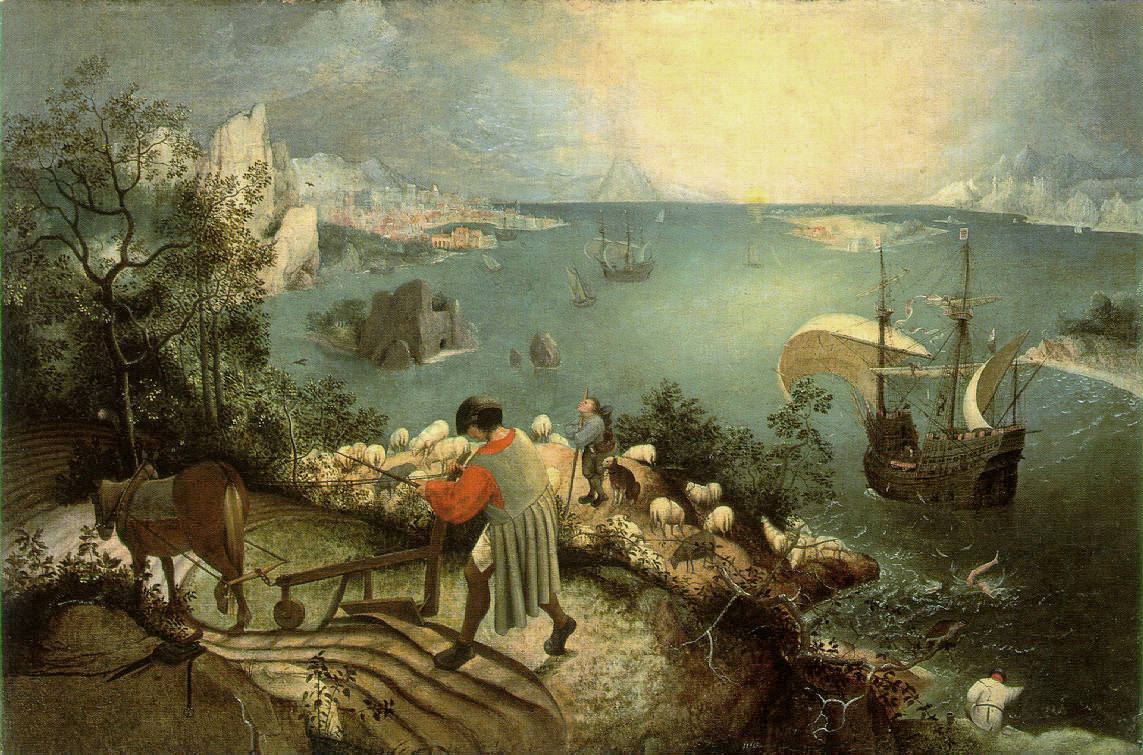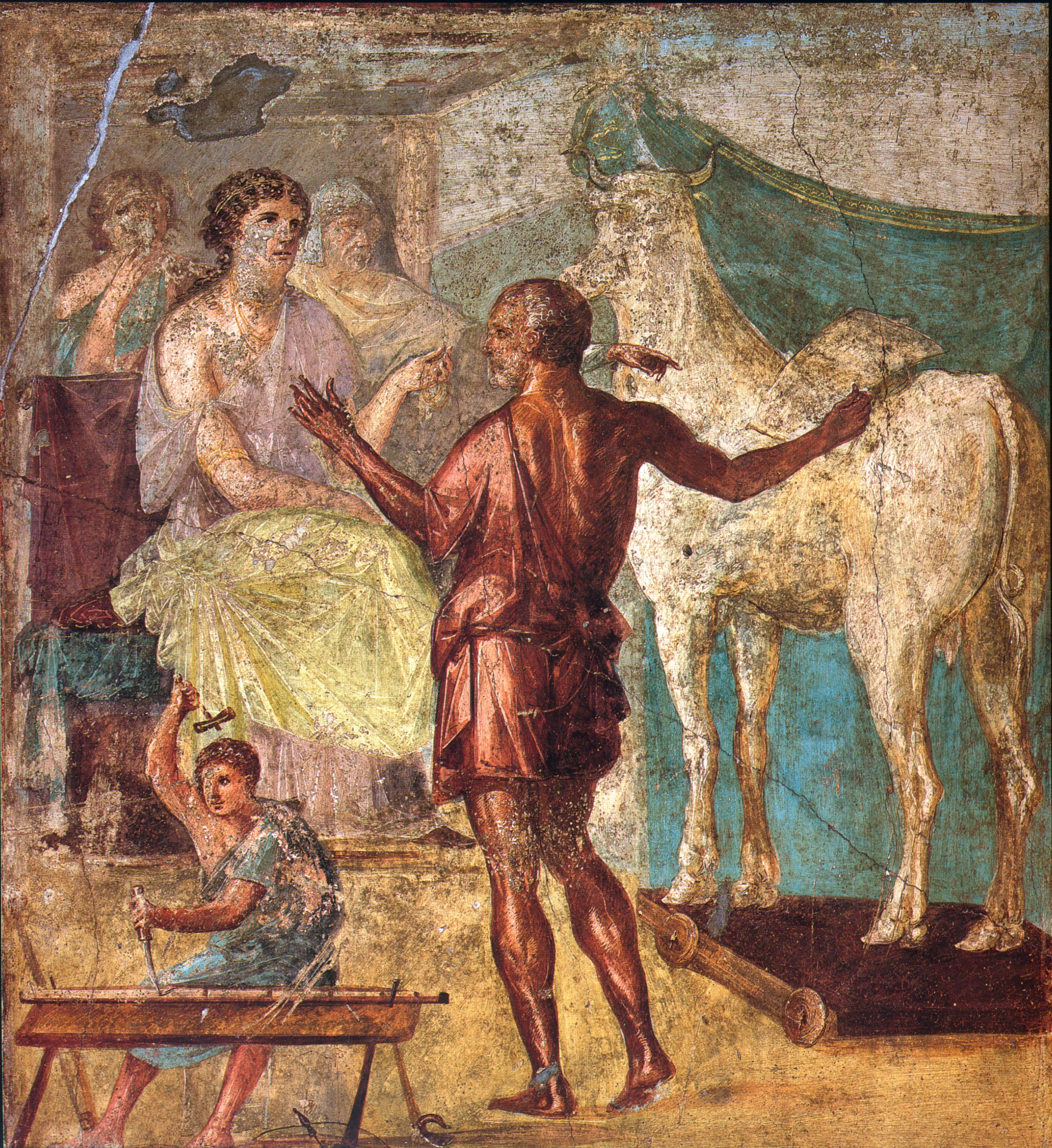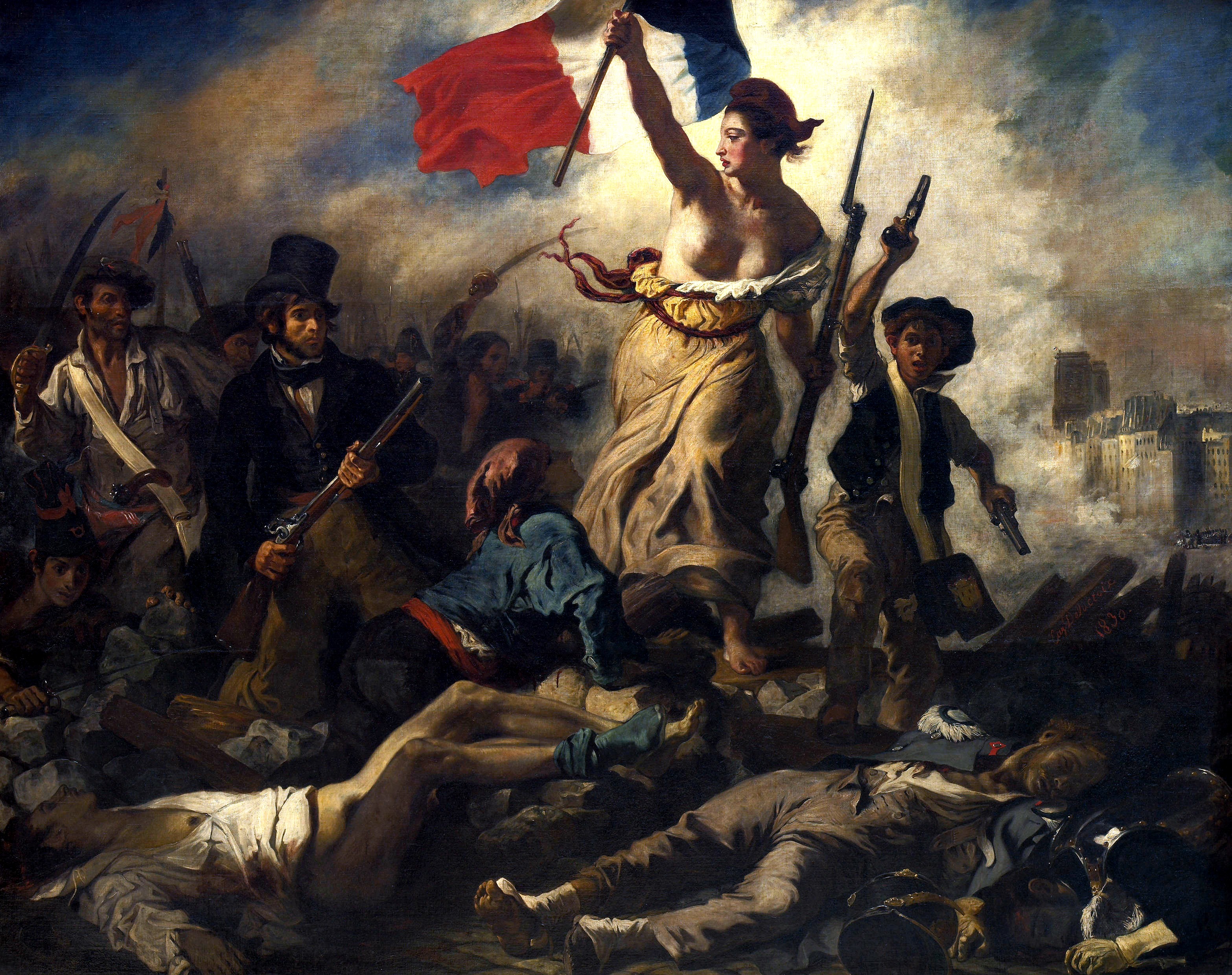|
Landscape With The Fall Of Icarus (poem)
"Landscape with the Fall of Icarus" is an ecphrastic poem by the 20th-century American poet William Carlos Williams that was written in response to ''Landscape with the Fall of Icarus'', traditionally attributed to Pieter Bruegel. Williams first published the poem as part of a sequence in ''The Hudson Review'' in 1960, subsequently using the sequence as the basis for his final book, ''Pictures from Brueghel and Other Poems'', published in 1962. The poem, as indicated by the title, touches upon the story from Ovid's ''Metamorphoses'', in which Icarus, the son of Daedalus, took flight from Crete, where he and his father were trapped in exile, wearing wings made from wax and feathers. Icarus, disregarding one of his father's wishes that he not fly too close to the sun, did just that and melted his way to a feathery demise, drowning in the sea. The other warning from Daedalus was to not fly to close to the sea or the feathers of Icarus' wings would get wet and thus fail. This subject ... [...More Info...] [...Related Items...] OR: [Wikipedia] [Google] [Baidu] |
Ecphrasis
The word ekphrasis, or ecphrasis, comes from the Greek for the written description of a work of art produced as a rhetorical or literary exercise, often used in the adjectival form ekphrastic. It is a vivid, often dramatic, verbal description of a visual work of art, either real or imagined. Thus, "an ekphrastic poem is a vivid description of a scene or, more commonly, a work of art." In ancient times, it might refer more broadly to a description of any thing, person, or experience. The word comes from the Greek ἐκ ''ek'' and φράσις ''phrásis'', 'out' and 'speak' respectively, and the verb ἐκφράζειν ''ekphrázein'', 'to proclaim or call an inanimate object by name'. The works of art described, or evoked, may be real or imagined; sometimes it is now hard to tell. Ancient ekphrastic writing can be useful evidence for art historians, especially where paintings are concerned, as virtually no original Greco-Roman examples survive. Ekphrasis has been cons ... [...More Info...] [...Related Items...] OR: [Wikipedia] [Google] [Baidu] |
United States
The United States of America (U.S.A. or USA), commonly known as the United States (U.S. or US) or America, is a country primarily located in North America. It consists of 50 U.S. state, states, a Washington, D.C., federal district, five major unincorporated territories, nine United States Minor Outlying Islands, Minor Outlying Islands, and 326 Indian reservations. The United States is also in Compact of Free Association, free association with three Oceania, Pacific Island Sovereign state, sovereign states: the Federated States of Micronesia, the Marshall Islands, and the Palau, Republic of Palau. It is the world's List of countries and dependencies by area, third-largest country by both land and total area. It shares land borders Canada–United States border, with Canada to its north and Mexico–United States border, with Mexico to its south and has maritime borders with the Bahamas, Cuba, Russia, and other nations. With a population of over 333 million, it is the List of ... [...More Info...] [...Related Items...] OR: [Wikipedia] [Google] [Baidu] |
Poet
A poet is a person who studies and creates poetry. Poets may describe themselves as such or be described as such by others. A poet may simply be the creator ( thinker, songwriter, writer, or author) who creates (composes) poems ( oral or written), or they may also perform their art to an audience. The work of a poet is essentially one of communication, expressing ideas either in a literal sense (such as communicating about a specific event or place) or metaphorically. Poets have existed since prehistory, in nearly all languages, and have produced works that vary greatly in different cultures and periods. Throughout each civilization and language, poets have used various styles that have changed over time, resulting in countless poets as diverse as the literature that (since the advent of writing systems) they have produced. History In Ancient Rome, professional poets were generally sponsored by patrons, wealthy supporters including nobility and military officials. F ... [...More Info...] [...Related Items...] OR: [Wikipedia] [Google] [Baidu] |
William Carlos Williams
William Carlos Williams (September 17, 1883 – March 4, 1963) was an American poet, writer, and physician closely associated with modernism and imagism. In addition to his writing, Williams had a long career as a physician practicing both pediatrics and general medicine. He was affiliated with Passaic General Hospital, where he served as the hospital's chief of pediatrics from 1924 until his death. The hospital, which is now known as St. Mary's General Hospital, paid tribute to Williams with a memorial plaque that states "We walk the wards that Williams walked". Life and career Williams was born in Rutherford, New Jersey, in 1883. His father, William George Williams, was born in England but raised from the age of 5 in the Dominican Republic; his mother, Raquel Hélène Hoheb, from Mayagüez, Puerto Rico, was of French extraction. Scholars note that the Caribbean culture of the family home had an important influence on Williams. Jeffrey Herlihy-Mera observes, "English was not ... [...More Info...] [...Related Items...] OR: [Wikipedia] [Google] [Baidu] |
Landscape With The Fall Of Icarus
''Landscape with the Fall of Icarus'' is a painting in oil on canvas measuring currently displayed in the Royal Museums of Fine Arts of Belgium in Brussels. It was long thought to be by the leading painter of Dutch and Flemish Renaissance painting, Pieter Bruegel the Elder. However, following technical examinations in 1996 of the painting hanging in the Brussels museum, that attribution is regarded as very doubtful, and the painting, perhaps painted in the 1560s, is now usually seen as a good early copy by an unknown artist of Bruegel's lost original, perhaps from about 1558. According to the museum: "It is doubtful the execution is by Bruegel the Elder, but the composition can be said with certainty to be his", although recent technical research has re-opened the question. Largely derived from Ovid, the painting is described in W. H. Auden's famous poem " Musée des Beaux-Arts", named after the museum in Brussels which holds the painting, and became the subject of a poem ... [...More Info...] [...Related Items...] OR: [Wikipedia] [Google] [Baidu] |
Pieter Bruegel The Elder
Pieter Bruegel (also Brueghel or Breughel) the Elder (, ; ; – 9 September 1569) was the most significant artist of Dutch and Flemish Renaissance painting, a painter and printmaking, printmaker, known for his landscape art, landscapes and peasant scenes (so-called Genre art, genre painting); he was a pioneer in making both types of subject the focus in large paintings. He was a formative influence on Dutch Golden Age painting and later painting in general in his innovative choices of subject matter, as one of the first generation of artists to grow up when religious subjects had ceased to be the natural subject matter of painting. He also painted no portraits, the other mainstay of Netherlandish art. After his training and travels to Italy, he returned in 1555 to settle in Antwerp, where he worked mainly as a prolific designer of old master print, prints for the leading publisher of the day. Only towards the end of the decade did he switch to make painting his main medium, and ... [...More Info...] [...Related Items...] OR: [Wikipedia] [Google] [Baidu] |
The Hudson Review
''The Hudson Review'' is a quarterly journal of literature and the arts. History It was founded in 1947 in New York, by William Arrowsmith, Joseph Deericks Bennett, and George Frederick Morgan. The first issue was introduced in the spring of 1948. Morgan edited the magazine from its founding until 1998, when Paula Deitz succeeded him. According to the ''Reviews website: "the magazine has dealt with the area where literature bears on the intellectual life of the time and on diverse aspects of American culture. It has no university affiliation and is not committed to any narrow academic aim or to any particular political perspective." In 2006, Princeton University libraries announced that they had acquired the archives of the journal, which included important works including an Ezra Pound manuscript. References External linksOfficial site [...More Info...] [...Related Items...] OR: [Wikipedia] [Google] [Baidu] |
Pictures From Brueghel And Other Poems
''Pictures from Brueghel and Other Poems'' is a 1962 book of poems by the American modernist poet/writer William Carlos Williams. It was Williams's final book, for which he wikt:posthumous, posthumously won the Pulitzer Prize for Poetry in 1963. Two previously-published collections of poetry are included: ''The Desert Music and Other Poems'' from 1954 and ''Journey to Love (William Carlos Williams), Journey to Love'' from 1955. Pieter Brueghel the Elder was a Flemings, Flemish painter (born c. 1525–1530, died 1569), famous for pictures of peasant life. This book opens with the title cycle of ten poems (the last poem is in three parts), each based on a Brueghel painting. References 1962 poetry books American poetry collections Poetry by William Carlos Williams New Directions Publishing books {{Poetry-collection-stub ... [...More Info...] [...Related Items...] OR: [Wikipedia] [Google] [Baidu] |
Daedalus
In Greek mythology, Daedalus (, ; Greek: Δαίδαλος; Latin: ''Daedalus''; Etruscan: ''Taitale'') was a skillful architect and craftsman, seen as a symbol of wisdom, knowledge and power. He is the father of Icarus, the uncle of Perdix, and possibly also the father of Iapyx. Among his most famous creations are the wooden cow for Pasiphaë, the Labyrinth for King Minos of Crete which imprisoned the Minotaur, and wings that he and his son Icarus used to escape Crete. It was during this escape that Icarus did not heed his father's warnings and flew too close to the sun; the wax holding his wings together melted and Icarus fell to his death. Epigraphic evidence The name ''Daidalos'' appears to be attested in Linear B, a writing system used to record Mycenaean Greek. The name appears in the form ''da-da-re-jo-de'', possibly referring to a sanctuary. Family Daedalus's parentage was supplied as a later addition, with various authors attributing different parents to him. Hi ... [...More Info...] [...Related Items...] OR: [Wikipedia] [Google] [Baidu] |
Modernist
Modernism is both a philosophy, philosophical and arts movement that arose from broad transformations in Western world, Western society during the late 19th and early 20th centuries. The movement reflected a desire for the creation of new forms of art, philosophy, and social organization which reflected the newly emerging industrial society, industrial world, including features such as urbanization, architecture, new technologies, and war. Artists attempted to depart from traditional forms of art, which they considered outdated or obsolete. The poet Ezra Pound's 1934 injunction to "Make it New" was the touchstone of the movement's approach. Modernist innovations included abstract art, the stream-of-consciousness novel, montage (filmmaking), montage cinema, atonal and twelve-tone music, divisionist painting and modern architecture. Modernism explicitly rejected the ideology of Realism (arts), realism and made use of the works of the past by the employment of reprise, incorpor ... [...More Info...] [...Related Items...] OR: [Wikipedia] [Google] [Baidu] |
Musée Des Beaux Arts (poem)
"Musée des Beaux Arts" (French for "Museum of Fine Arts") is a poem written by W. H. Auden in December 1938 while he was staying in Brussels, Belgium, with Christopher Isherwood. It was first published under the title "Palais des beaux arts" (Palace of Fine Arts) in the Spring 1939 issue of ''New Writing'', a modernist magazine edited by John Lehmann. It next appeared in the collected volume of verse ''Another Time'' (New York: Random House, 1940), which was followed four months later by the English edition (London: Faber and Faber, 1940). The poem's title derives from the Musées Royaux des Beaux-Arts de Belgique in Brussels, famous for its collection of Early Netherlandish painting. Auden visited the Musée and would have seen a number of works by the "Old Masters" of his second line, including Pieter Bruegel the Elder. Synopsis "Musee des Beaux Arts" by W.H. Auden describes, through the use of one specific artwork, the impact of suffering on humankind. Auden's free ver ... [...More Info...] [...Related Items...] OR: [Wikipedia] [Google] [Baidu] |





